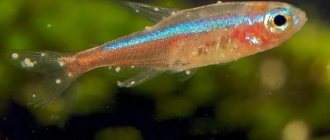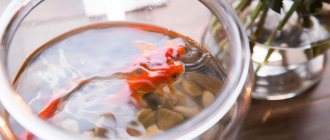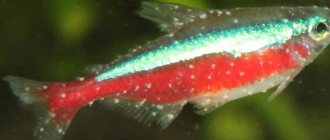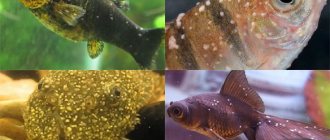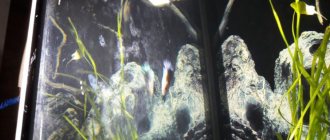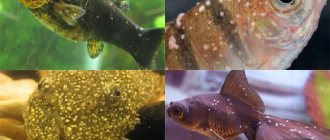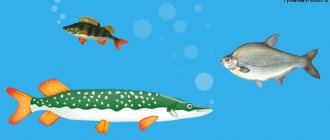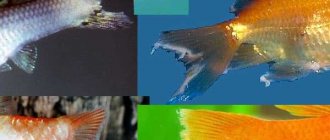Ancistrus diseases are a topic that worries many aquarists, and with good reason. It is always difficult to lose your favorite fish, and when the first symptoms of the disease are detected, you want to immediately begin treatment in order to save the maximum number of fish.
But when it comes to ancistrus, some difficulty arises - it is quite difficult to notice the first symptoms of the disease on fish that are nocturnal and spend most of their time in shelters.
And we learn about the disease quite late. What diseases occur in ancistrus and how to fight them - we will figure it out together today.
Description
Neons are tiny fish that live in small schools. Their main characteristics are:
- average length up to 3 centimeters;
- bright color;
- a stripe of rich color runs through the entire body, for example, blue, red, black;
- the fins are very short and practically invisible;
- females are much larger than males;
- They prefer spacious aquariums with slightly acidic water;
- on average, they live from 2 to 2.5 years (with proper care);
- they are considered absolutely picky when it comes to food;
- can reproduce successfully if certain conditions are created for this.
Such fish are very beautiful and are not aggressive representatives of the aquatic world.
Kinds
The most common types of neons are:
- Blue, they got their name because of the horizontal blue stripe running along the entire body. Such representatives: under good conditions in an aquarium can live up to 3 years;
- get along well with other species (but not predatory ones). Note: The blue variety is considered to be the most adaptable among other neons.
- length that reaches no more than 3 centimeters;
- relatively large size, up to 4 centimeters;
Dropsy
This disease is one of the most difficult in Ancistrus. There is not much information on this matter on the Internet, but I had to dig around on the forums to put the picture together.
This disease in Anzstrus looks like a very swollen belly. As many owners think at first, well, he ate too much Ancistrus and his stomach became swollen. It will go away on its own, no big deal. And a couple of days later Ancistrus died. And here questions arise.
In an ancistrus with a swollen belly, the anus swells and the fish stops defecating.
Several factors can cause this problem:
- drug poisoning;
- ammonia poisoning;
- NO2 poisoning;
- kidney damage;
- fluid imbalance;
- live food poisoning;
- lack of cellulose in the diet.
The options under consideration are possible, but it is impossible to say definitely what caused the dropsy. According to Ancistrus breeders, if young fish grow without driftwood in a nursery aquarium, then with a very high degree of probability the fry will face a similar problem and in most cases the fish will die.
If you see a similarly swollen belly of an ancistrus, you need to remove it from the general aquarium and begin treatment with Baktopur (ciprofloxacin 50 ml/l) or you can use chloramphenicol 75 ml/l and salt 1.5-2 mg/l.
Maintain the temperature at 27 degrees. The benefits of treatment will be obvious when the catfish's belly begins to become smaller and it is able to defecate. After this, you should keep him on medication for another 2-3 days.
The trouble with this disease is that if you pay attention to the problem with the fish too late, the treatment will not lead to a good result and the fish will die anyway. As is not the only opinion of forum members, there is no reason in most cases to drag a catfish from the other world. About 80 percent of the fish cannot be cured. But in refutation on the same forums there are many successful operations to save catfish from dropsy.
Rules of care
Neons require proper care, otherwise such a fish will not survive or it will be highly susceptible to various diseases. There are no particular difficulties in this matter, the main thing is to strictly adhere to some recommendations:
Monitor the condition of the aquarium:
- wash and change water regularly;
- install small filters (internal and external);
- always maintain a temperature of 21 to 27 degrees Celsius, depending on the type of individual; Note: the ideal temperature is 22−24 degrees, especially for young neons.
- drain the water every day, up to a quarter of the total volume, and replace it with clean water;
- Always maintain slightly acidic water (from 5.5 to 7 pH) and moderately hard.
Follow feeding rules:
- purchase feed as small as possible;
- constantly change them to other types to ensure a variety of food;
- buy high-quality food and monitor its expiration date;
- give in the dosage required for a specific type of fish and taking into account their number in the aquarium.
Advice: when choosing food, especially for beginners, it is worth consulting with specialists or sellers at a pet store.
Interesting fact: neons are very fond of bloodworms, it is recommended to occasionally purchase such a delicacy for them.
Treatment of ichthyophthyriosis
Previously, it was believed that semolina fish disease was easily treatable. But any form of life evolves, ciliates are no exception. And now it is becoming difficult to cure fish from this disease.
Treatment of semolina in fish should be started immediately at the first signs of the disease. An advanced infection will destroy the largest inhabitants in just a few days. It is important to remember that the defeat of one fish leads to the development of pathology in absolutely all inhabitants. Therefore, treating ichthyophthyriasis in a community aquarium is the best option, allowing you to get rid of the parasites entirely.
First you need to remove all equipment and decor from the aquarium. It is best to replace them with new ones. Can be treated with boiling water and soaked in furatsilin. Then develop a treatment method, taking into account the characteristics of all the inhabitants of the aquarium. The fact is that some drugs can cure some fish, but kill other fish.
The first thing to do is raise the temperature of the water. The increase threshold is 32 degrees. This is done to accelerate the development of ciliates and leads to their death. But you need to remember that not all aquarium inhabitants can withstand such temperatures. It is better to place such fish in another container and treat them using other methods.
An increase in temperature causes an immediate response from the fish's immune system, but can be harmful to those pets whose gills are severely damaged. This method must be used with caution so as not to kill the fish.
The chemical and medicinal method involves the use of such means as:
- Using table or sea salt
- Adding the drug “malachite green”,
- Treatment of water with hydrogen peroxide,
- The use of furatsilin,
- Medications.
Salt method
Treatment of semolina with salt is carried out in a common aquarium. The amount of salt depends on the volume of water. The calculation is as follows: 1 tablespoon per 10 liters of water. Preliminary dissolution of the salt is not required; it can be poured directly into the water. In this case, it is necessary to gradually increase the water temperature. The fish will float to the surface of the water. This is normal, since a concentrated salt solution is formed below, which is destructive for the pathogen. The duration of the procedure is 14 days. Then, for a month, the water is changed every week. Substitution volume 30%.
"Malachite green"
Highly toxic product, sanitary conditioner for aquarium water. They work with it wearing gloves. The medicine requires preliminary preparation. The solution is prepared at the rate of 0.09 mg per 1 liter of water. This concentration of the solution does not cause any particular harm. Of course, the inhabitants have a hard time, but they have no choice. Either treatment or death. The only thing that is taken into account is the presence of scaleless fish species. For such pets, the concentration is reduced to 0.06 mg/l. When using “malachite green”, a partial water change is necessary. This is done like this: replacing the water, then adding the drug. Treatment is carried out until the signs of the disease completely disappear and for several more days to consolidate the therapeutic effect.
Hydrogen peroxide
To treat semolina in a general aquarium with hydrogen peroxide, take a 3% solution. You need to add it carefully, as there is a risk of burning the fins. No more than 1 ml per 10 liters of water. Peroxide works like an oxygen mask. It becomes easier for “patients” to breathe, as peroxide enriches the water with oxygen.
Furacilin
An absolutely safe method of treating semolina with furatsilin will help you quickly get rid of the problem. To prepare the solution, take 1 tablet per 30–40 liters of water. Furacilin infusions are given every other day, replacing 30% of the volume of water.
Medicines
An ichthyologist will advise you on how to treat fish for semolina with medications. In the absence of one, they contact a veterinarian at the nearest clinic. If difficulties arise here, purchase the following medications:
- Antipar,
- Furazolidone,
- Delagil,
- Bicillin – 5,
- Contractal,
- Omnisan,
- Kostapur,
- Ektopur,
- Mikopur.
Content
For a comfortable life as a neon, certain conditions are required. The main thing in this question is:
- Launch the fish when the water has stood and no fluctuations are observed. Advice: if the aquarium is new, then a few days before adding neons to it, prepare all the conditions and let the water brew.
- The aquarium must contain: plants that are planted fairly densely and must be in dark soil;
- small driftwood; Tip: on average, 2-3 driftwood is enough.
- special places where the fish can hide from bright light. Tip: you can buy small houses at pet stores that are installed on the bottom.
White spots
A similar phenomenon, although not very often, sometimes occurs on Ancistrus catfish. But before you start pouring a bunch of chemicals from all sorts of jars into the aquarium, saving your pet, it’s worth figuring out whether these are stains at all. The fact is that the so-called white spots are very easy to confuse with stress coloring.
When under stress, ancistrus become dimmer than usual. For example, if you are transplanting catfish from one container to another. Similar stress can also arise in everyday life for fish - high competition for food, small capacity for many Ancistrus individuals, or a completely densely populated aquarium. And in some cases, the color may not be lost throughout the entire body, but in parts.
If we are already talking about the disease, then in loricariids quite often white spots can form on the body. The cause of this problem is an infection. Most likely, such things end up in the aquarium with fish that you recently bought at the pet store.
It is worth remembering that having bought a new fish, before introducing it into a community aquarium, keep it in quarantine for 10-14 days, watch it, and if any problem arises with this fish, you will protect all the other inhabitants of the aquarium, and maybe even save im life this way.
If you find a catfish on your body, the patient must be urgently isolated from all other fish and quarantined. For a quarantine aquarium, a capacity of about 20 liters will suit you.
This problem is treated with the drug Antipar. It is worth noting that it is not worth setting up a quarantine aquarium. After treatment, the fish will return to its home, and this aquarium will need to be treated and disinfected. This is easier to do when the aquarium is empty.
As practice shows, this disease spreads very quickly between catfish, which is why it is necessary to urgently remove infected fish from the common aquarium. If you have no options about the exact cause of the infection and the name of the disease, contact a specialist to prescribe the drug needed for treatment. Attempting to cure all fish diseases using all the drugs you know can speed up your pet’s departure to another world.
Compatibility
Neons themselves do not pose any danger to other inhabitants.
However, they can easily become prey for predatory species, so it is better for the following individuals to get along with them:
- platies;
- guppy;
- cardinals;
- iris;
- swordtails;
- barbs.
An interesting point: you can safely plant angelfish with them, despite their large size, they are not aggressive and do not pose a danger to neons.
Reproduction
Some difficulties may arise with reproduction, since they require special water conditions for this. In order for neons to give birth to offspring, it is required:
- Provide a separate small aquarium in which: the water is extremely soft from 5 to 6 pH;
- the temperature is constantly maintained at 24-25 degrees;
- the average volume should be from 8 to 10 liters for one pair; Note: for two pairs you will need a larger aquarium, preferably 20 liters.
- light is practically excluded; Advice: it is better to cover all the walls with thick paper or cloth and place the aquarium in a place as far away from sunlight as possible.
- Put plenty of moss on the bottom, otherwise the female will have nowhere to lay eggs. Note: instead of moss, a nylon washcloth works great, but only as large as possible.
- drain the water so that no more than 10 centimeters remain above the bottom;
It is important to exclude any filters at first, otherwise all the fry will die.
The causative agent of the disease
You need to know the enemy by sight. Knowing the nature of the pathogen, it is easier to cope with the disease of aquarium fish without resorting to radical measures.
The incubation period for the development of ciliates lasts from 7 days to two weeks. The parasite's favorite places are the inner layers of the skin and gills. After incubation, the first signs of damage appear on the body of the fish. The parasite feeds on the tissues of the host. In warm water, ciliates grow and multiply quickly. After some time, the tubercles burst, the ciliates leave the fish’s body and settle on all surfaces of the aquarium: plant leaves and decor. Cystoid formations appear on them, in which the larvae of the parasite mature. The formed larva leaves the cyst and drifts freely in the water column, waiting for its next victim. That is why overcrowding of the aquarium becomes the main reason for the rapid defeat of its inhabitants.
Why do neon fish die?
The reasons for the death of neons can be different, most often this is observed as a result of:
- Inappropriate care conditions: if temperature conditions are not observed;
- no filters;
- water is not changed regularly;
- incorrect approach to feeding;
- the water is too hard or, conversely, soft, etc.
Note: with plistophorosis, the stripe running along the body noticeably turns pale, so if such a change begins to be observed in some fish, then you should try to save others by moving the sick individual to another aquarium.
Causes of semolina
The cause of the fish disease is the ciliated ciliate parasite. It lives in all bodies of water. All freshwater fish get sick with semolina. As for aquarium fish, infection occurs as a result of the introduction of ciliates with sick fish, snails taken from a natural reservoir or with natural soil that has not undergone heat treatment. For the development of a parasite in an aquarium, certain factors are needed:
- Poor aquarium hygiene,
- Errors in water parameters,
- Poor food and eating disorders,
- Too many fish
